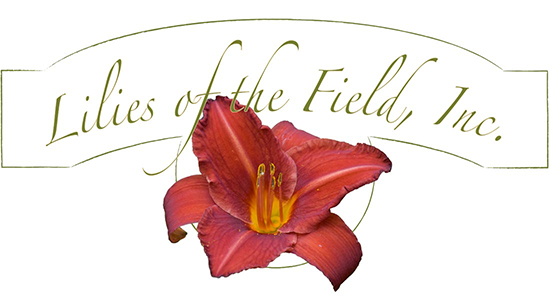Today at the Lilies’ gardens we have an abundance of Hollyhocks. Our original plants came from a nursery, as most of our plants do, but these have been extremely fruitful plants, reproducing from seed all over the garden.

Hollyhocks are tall slender plants with leaves similar to grape leaves, with different lobes or sections. The flowers are mostly yellow or pink. Although there are a few other colors, like dark purple, ours are mostly shades of pink or yellow. Flowers surround the stem, mostly at the top, which can grow to be almost 12 feet tall. Our plants range from 4 feet to 8 feet currently, but in past years we have had them reach upward of eleven feet. This makes them blow around in the wind quite a bit, which necessitates staking, although the Hollyhock stem is generally quite strong. Flowers are abundant and bloom for what seems like an eternity. One variety has a single layer of petals with a strong central stamen, and another has at least two rows of petals. Of course, the flowers which have a single row of petals are easier to press for use in our cards and prints, but both are very beautiful.

Hollyhocks are known as such but their true name is Alcea, and they are native to southwest and central Asia, with some species native to southeastern Europe and even Egypt. (Wikipedia) There are many varieties of Hollyhocks, and I am not sure how many we currently have. I suppose 3 to 6 different varieties out of around 60 live in and love our garden.
In the Language of Flowers (www.languageofflowers.com) Hollyhocks symbolize ambition and fecundity. For those of you like myself, who might not know, fecundity means “producing or capable of producing abundance of offspring or new growth”. This definition is most apt for the Alcea. Of all of its characteristics the ability to reproduce is at the top of the list. We have found Hollyhocks abounding in places almost unimaginable. In between the bricks on one of our patios, we regularly find seedlings popping up. This is not to mention all of the abundant reproduction we find in other areas of the garden. Even in late summer we have new seedlings popping their heads up out of the ground, ever eager to begin their new lives.

Transplanting the Alcea is a bit tricky. We attempted it in late spring, and the tap roots of the plants were already a foot or more deep. Once transplanting was accomplished, the plants did not reach the height they normally would have, although they did survive.
Truth be known, we appreciate the Hollyhock for its nature, bold, fruitful and beautiful. It occupies a place in the forefront of our garden, intermixed with lilies and other wild flowers, which fortunately bloom at the same time as the hollyhock.
If someone in your life is ambitious and fruitful, consider sending them a hollyhock or a card with a hollyhock on it. Your message won’t be forgotten.


